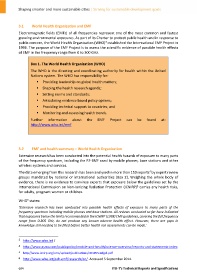Page 614 - Shaping smarter and more sustainable cities - Striving for sustainable development goals
P. 614
3.1 World Health Organization and EMF
Electromagnetic fields (EMFs) of all frequencies represent one of the most common and fastest
growing environmental exposures. As part of its Charter to protect public health and in response to
3
public concern, the World Health Organization (WHO) established the International EMF Project in
1996. The purpose of the EMF Project is to assess the scientific evidence of possible health effects
of EMF in the frequency range from 0 to 300 GHz.
Box 1. The World Health Organization (WHO)
The WHO is the directing and coordinating authority for health within the United
Nations system. The WHO has responsibility for:
Providing leadership on global health matters;
Shaping the health research agenda;
Setting norms and standards;
Articulating evidence based policy options;
Providing technical support to countries; and
Monitoring and assessing health trends.
Further information about the EMF Project can be found at:
http://www.who.int/emf
3.2 EMF and health summary – World Health Organization
Extensive research has been conducted into the potential health hazards of exposure to many parts
of the frequency spectrum, including the RF‐EMF used by mobile phones, base stations and other
wireless systems and services.
4
The data emerging from this research has been analysed in more than 150 reports by expert review
groups mandated by national or international authorities (Box 2). Weighing the whole body of
evidence, there is no evidence to convince experts that exposure below the guidelines set by the
5
International Commission on Non‐Ionizing Radiation Protection (ICNIRP) carries any health risks,
for adults, pregnant women or children.
6
WHO states:
‘Extensive research has been conducted into possible health effects of exposure to many parts of the
frequency spectrum including mobile phones and base stations. All reviews conducted so far have indicated
that exposures below the limits recommended in the ICNIRP (1998) EMF guidelines, covering the full frequency
range from 0‐300 GHz, do not produce any known adverse health effect. However, there are gaps in
knowledge still needing to be filled before better health risk assessments can be made.’
____________________
3 http://www.who.int /
4 http://www.gsma.com/publicpolicy/mobile‐and‐health/science‐overview/reports‐and‐statements‐index
5 http://www.icnirp.org/cms/upload/publications/ICNIRPemfgdl.pdf
6 http://www.who.int/peh‐emf/research/en/. Accessed 5 September 2014.
604 ITU‐T's Technical Reports and Specifications

